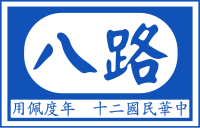Eighth Route Army
This article needs additional citations for verification. (January 2017) |
| 18th Group Army of the National Revolutionary Army (Eighth Route Army) | |
|---|---|
 | |
| Active | 1937–1947 |
| Country | |
| Allegiance | |
| Branch | |
| Type | Route Army |
| Role | Infantry |
| Size | 600,000 |
| Part of | CPC Central Military Commission Nationalist Government Military Affairs Commission |
| Garrison/HQ | Shanxi Province and Shaanxi Province |
| Colors | Grey and White Uniform |
| Engagements | Second Sino-Japanese War, Chinese Civil War |
| Commanders | |
| Commander | Zhu De |
| Deputy Commander | Peng Dehuai |
| Insignia | |
| Arm badge, as Eighth Route Army |  |
| Arm badge, as 18th Group Army |  |


The Eighth Route Army (simplified Chinese: 八路军; traditional Chinese: 八路軍; pinyin: Bālù-Jūn), officially known as the 18th Group Army of the National Revolutionary Army of the Republic of China, was a group army under the command of the Chinese Communist Party, nominally within the structure of the Chinese military headed by the Chinese Nationalist Party during the Second Sino-Japanese War.
The Eighth Route Army was created from the Chinese Red Army on September 22, 1937, when the Chinese Communists and Chinese Nationalists formed the Second United Front against Japan at the outbreak of the Second Sino-Japanese War, as World War II is known in China. Together with the New Fourth Army, the Eighth Route Army formed the main Communist fighting force during the war and was commanded by Communist party leader Mao Zedong and general Zhu De. Though officially designated the 18th Group Army by the Nationalists, the unit was referred to by the Chinese Communists and Japanese military as the Eighth Route Army. The Eighth Route Army wore Nationalist uniforms and flew the flag of the Republic of China and waged mostly guerrilla war against the Japanese, collaborationist forces and, later in the war, other Nationalist forces. The unit was renamed the People's Liberation Army in 1947, after the end of World War II, as the Chinese Communists and Nationalists resumed the Chinese Civil War.

The Eighth Route Army consisted of three divisions (the 115th, which was commanded by Lin Biao, the 120th under He Long, and the 129th under Liu Bocheng). During World War II, the Eighth Route Army operated mostly in North China, infiltrating behind Japanese lines, to establish guerrilla bases in rural and remote areas. The main units of the Eighth Route Army were aided by local militias organized from the peasantry.
The Communist Party's liaison offices in cities under Nationalist control such as Chongqing, Guilin and Dihua (Ürümqi) were called Eighth Route Army Offices.
Ethnic Koreans who fought in the Eighth Route Army later joined the Korean People's Army.
Norman Bethune, a Canadian physician and communist, died while serving as a medic with the Eighth Route Army.[1]
Organization
1937
In August 1937, the Eighth Route Army had three divisions.
| Division | Commander | Order of battle | Commander | Troop strength |
|---|---|---|---|---|
| 115th Division | Lin Biao (林彪) | 343th Brigade | Chen Guang (陈光) | 15,000 |
| 344th Brigade | Xu Haidong (徐海东) | |||
| Independent Regimental | Yang Chengwu (杨成武) | |||
| 120th Division | He Long (贺龙) | 358th Brigade | Lu Dongsheng (卢冬升) | 14,000 |
| 359th Brigade | Chen Bojun (陈伯钧) | |||
| Teaching Regimental | Peng Shaohui (彭绍辉) | |||
| 129th Division | Liu Bocheng (刘伯承) | 385th Brigade | Wang Hongkun (王宏坤) | 13,000 |
| 386th Brigade | Chen Geng (陈赓) | |||
| Teaching Regimental | Zhang Xian (张贤) |
1940
In Winter 1940 the Eighth Route Army had increased to 400,000 soldiers.
| Division | Commander | Order of battle | Commander | Troop strength |
|---|---|---|---|---|
| 115th Division | Chen Guang (陈光) | 1st Teaching Brigade | Peng Mingzhi (彭明治) | 70,000 |
| 2nd Teaching Brigade | Zeng Guohua (曾国华) | |||
| 3rd Teaching Brigade Western Shandong Military Region |
Yang Yong (杨勇) | |||
| 4th Teaching Brigade Western Lake Military Region |
Deng Keming (邓克明) | |||
| 5th Teaching Brigade | Liang Xingchu (梁兴初) | |||
| 6th Teaching Brigade Shandong and Hebei Military Region |
Xing Renfu (邢仁甫) | |||
| Southern Shandong Military Region | Zhang Guangzhong (张光中) | |||
| Shandong Column | Zhang Jingwu (张经武) | 1st Brigade | Wang Jian'an (王建安) | 51,000 |
| 2nd Brigade | Sun Jixian (孙继先) | |||
| 3rd Brigade | Xu Shiyou (许世友) | |||
| 5th Brigade | Wu Kehua (吴克华) | |||
| 1st Detachment | Hu Qicai (胡奇才) | |||
| 4th Detachment | Zhao Jie (赵杰) | |||
| 5th Detachment | Wang Bin (王彬) | |||
| 120th Division Western and Northern Shanxi Military Region |
He Long (贺龙) | 1st Independent Brigade 4th Military Subarea |
Gao Shiyi (高士一) | 51,000 |
| 2nd Independent Brigade 2nd Military Subarea |
Peng Shaohui (彭绍辉) | |||
| 358th Brigade 3rd Military Subarea |
Zhang Zongxun (张宗逊) | |||
| 2nd Shanxi Youth Column 8th Military Subarea |
Han Jun (韩钧) | |||
| Cavalry Detachment | Yao Zhe (姚喆) | |||
| 129th Division | Liu Bocheng (刘伯承) | Taihang Mountain Military Subarea | Liu Bocheng (刘伯承) | 56,000 |
| 386th Brigade Taiyue Mountain Military Subarea |
Chen Geng (陈赓) | |||
| Southern Hebei Military Subarea | Chen Zaidao (陈再道) | |||
| Shanxi, Hebei and Chahaer Military Region | Nie Rongzhen (聂荣臻) | 1st Military Subarea | Yang Chengwu (杨成武) | 100,000 |
| 2nd Military Subarea | Guo Tianmin (郭天民) | |||
| 3rd Military Subarea | Huang Yongsheng (黄永胜) | |||
| 4th Military Subarea | Xiong Botao (熊伯涛) | |||
| 5th Military Subarea | Deng Hua (邓华) | |||
| 3rd Column Middle Hebei Military Region |
Lv Zhengcao (吕正操) | |||
| Advanced Detachment | Xiao Ke (萧克) | |||
| Shaanxi Left Behind Corps | Xiao Jinguang (肖劲光) | 385th Brigade | Wang Weizhou (王维舟) | 22,600 |
| 359th Brigade | Wang Zhen (王震) | |||
| 1st Security Brigade | Wen Niansheng (文年生) | |||
| Security Command | Gao Gang (高岗) | |||
| Others | 2nd Column Hebei, Shandong and Henan Military Region |
Yang Dezhi (杨得志) | 50,000 | |
| 4th Column | Peng Xuefeng (彭雪枫) | |||
| 5th Column | Huang Kecheng (黄克诚) |
See also
References
- ^ Tse-tung, Mao. "IN MEMORY OF NORMAN BETHUNE". www.marxists.org.
